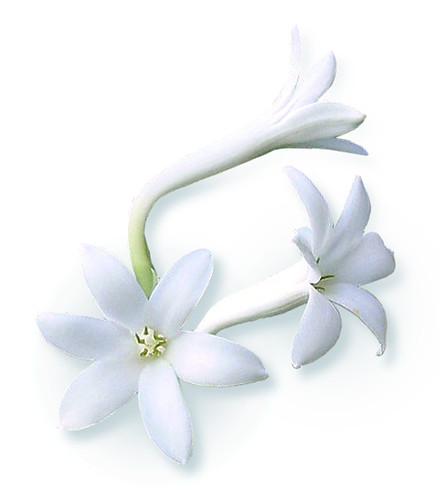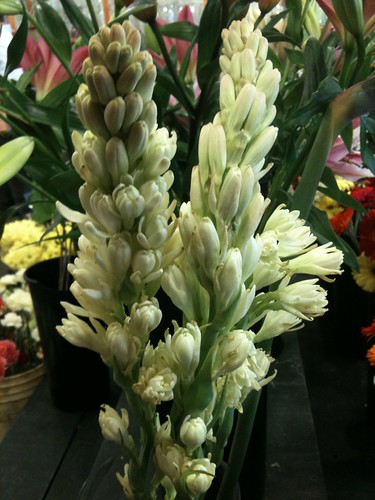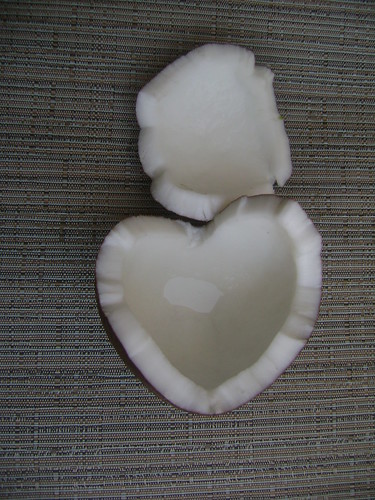 Polianthes tuberosa - single stemmed flowers, the ones that are used for perfumery.
Polianthes tuberosa - single stemmed flowers, the ones that are used for perfumery. To the layperson, the mention of tuberose usually brings to mind “rose”. The name, however, refers to the tuberous roots of the plant, which is related to narcissus and is native to Central America and Mexico. Nowadays, it is mostly cultivated in India and to a lesser extent in Egypt and in Southern France. Currently there are only two tuberose fields left in Grasse, which are processed by enfleurage: the preferred method for this flower, which possesses the rare quality of emitting more scent after it’s been cut and separated from the plant. Therefore, enfleurage is actually more cost effective as it yields much more absolute than by solvent extraction. Enfleurage, however, is not possible in India because of cultural and religious restrictions: for enfleurage requires two types of animal fats - and tallow. Cows are sacred to the Hindus, and pork is prohibited by the Muslims - two major populations in the flower growing regions of India. The good news is, that Indians are currently exploring enfleurage with vegetable fats - certainly something to look forward to!
The flowers themselves look somewhat like lilies arranged on a tall stalk that is one meter in height. The plants grow from a bulb for 4 years before they bloom in July! This of course furthers the cost of the absolute as the land remains in use but with no profitable crop for so long.The tuberose for perfumery is different species than the one for bouquets that you’d find at the florist (though their scent is similar) – they are from the single flower variety, where as the ornamental ones (grown in gardens and available in the flower shops) have two flowers clustered together on the stem.
As far as the fragrance goes - tuberose has made a name for itself as a narcotic, sedative scent that is dangerously seductive to the senses and even has the powers to make innocent girls unable to control themselves sexually. Virgins and young girls are not permitted on the tuberose fields after dark from fear that their innocence will be compromised... As a perfume, tuberose scents are known for being grand and at times even obnoxious (i.e.: Poison, Fracas, Jardin de Bagatelle, Carnal Flower, etc).
Tuberose absolute, however, is everything but loud and obnoxious. It is soft, smooth, waxy, with hints of green and almost mushroomy qualities. Some specimens might feel a bit rubbery or medicinal - and this can be either an interesting and desirable quality or an unwanted one, depending on the perfumer's perspective. The best tuberose would feel buttery, creamy and with sweet grape top notes from methyl antrhanilate (also present in large amounts in orange blossom, ylang ylang and other white floral notes). A somewhat off-putting medicinal note may also be present, reminiscent of wintergreen or birch - which comes off the methyl salicilate that is also one of the constituents.
According to
Bo Jensen, tuberose’s chemical makeup comprises of “benzyl alcohol and -acetate, methyl and benzyl benzoate, methyl salicylate, methyl anthranilate, eugenol, geraniol and nerol and -acetates, and farnesol, but its power and original effect is due to a multitude of gamma- and delta-lactones, some of them only found in tuberose” (i.e.: 6(Z),9(Z)-dodecadiene-4-olide, tuberolide and tuberolactone). It is probably those lactones that account for that creamy-dreamy, buttery characteristic of a good tuberose absolute, which is even more obvious in the tuberose floral wax.
 Tuberose at the flower shop - this is a different variety, that is double-stemmed.
Tuberose at the flower shop - this is a different variety, that is double-stemmed. To say that
tuberose is one of my favourite raw materials would be an understatement. It's the queen of the flowers, mistress of the night and a welcome participant in too many perfumes I've created. I say "too many" because it is a very costly raw material, going for about 8,000 per kilo, making some of my perfumes almost unrealistic for commerce.
White Potion was the first perfume I've created with it, back in my very early days in 2001. In White Potion, the tuberose plays centre stage but has a very muted, well-mannered persona (thus making it a perfect member of the
Language Of Flowers - my soliflore collection that is an homage to time past where soliflores were synonymous with elegance and refinement. And it was particularly fun to use tuberose in the other spin-offs of White Potion: the
body oil, which only "opens up" once it's on the skin (due to how the salicilates are behaving in the oil base - they are almost "invisible") and in the
fragrant white chocolate bar. I used it later in my contemporary, all-natural soliflores to give a white floral, creamy nuance in
Gigi (gardenia soliflore, where tuberose has a traditional place to accentuate the big white floral qualities of gardenia),
InCarnation (carnation soliflore) and
Zohar (orange blossom soliflore).
Schizm, also created in 2001 - was an outrageous Chypre floral animalic, with all the white florals imaginable (tuberose, orange blossom, sambac and grandiflorum jasmines), counterbalanced with dry cedarwood and salty oakmoss, and a touch of tart mandarin and savoury cepes and black pepper. Schizm was the first perfume I created with a name in mind first - and than the perfume came along. The concept was for a perfume with "schism" or division with it; and indeed, it begins more dry and almost acrid; yet develops into this sensual, floral-musky chypre.
In
Razala, tuberose plays in the exotic, nearly erotic fantasy of an animalic, Arabian-inspired perfume. It has all the makings of a harem perfume: myrrh, oud, ambergris, saffron, rose... Tuberose gives it a creamy touch which along with the magnolia brightens it and brings some light into a rather dense and seductive composition.
l'Écume des Jours is that rare place where my wildest imagination followed Boris Vian's book of the same name. It is a true fantasy perfume, and the tuberose played a role in the deadly "lung water lily accord" - which is simply a made-up illness that only Boris Vian could come up with and make it seem beautiful.
Last but not least is
Treazon: my newest perfume, which is a study in tuberose that has gone wild (more on that in a separate post). It's like White Potion's evil sister, accentuating all the aspects in tuberose that are more controversial and disagreeable. It was done before me (it was compared to Tubereuse Criminelle, which does not surprise me), but this one is with natural ingredients, exaggerating the salicylic aspects with an overdose of wintergreen and utilizing lactonic notes such as massoia bark to bring forth that creamy, milky and sweet aspect of tuberose, yet keep it dark and extreme.




